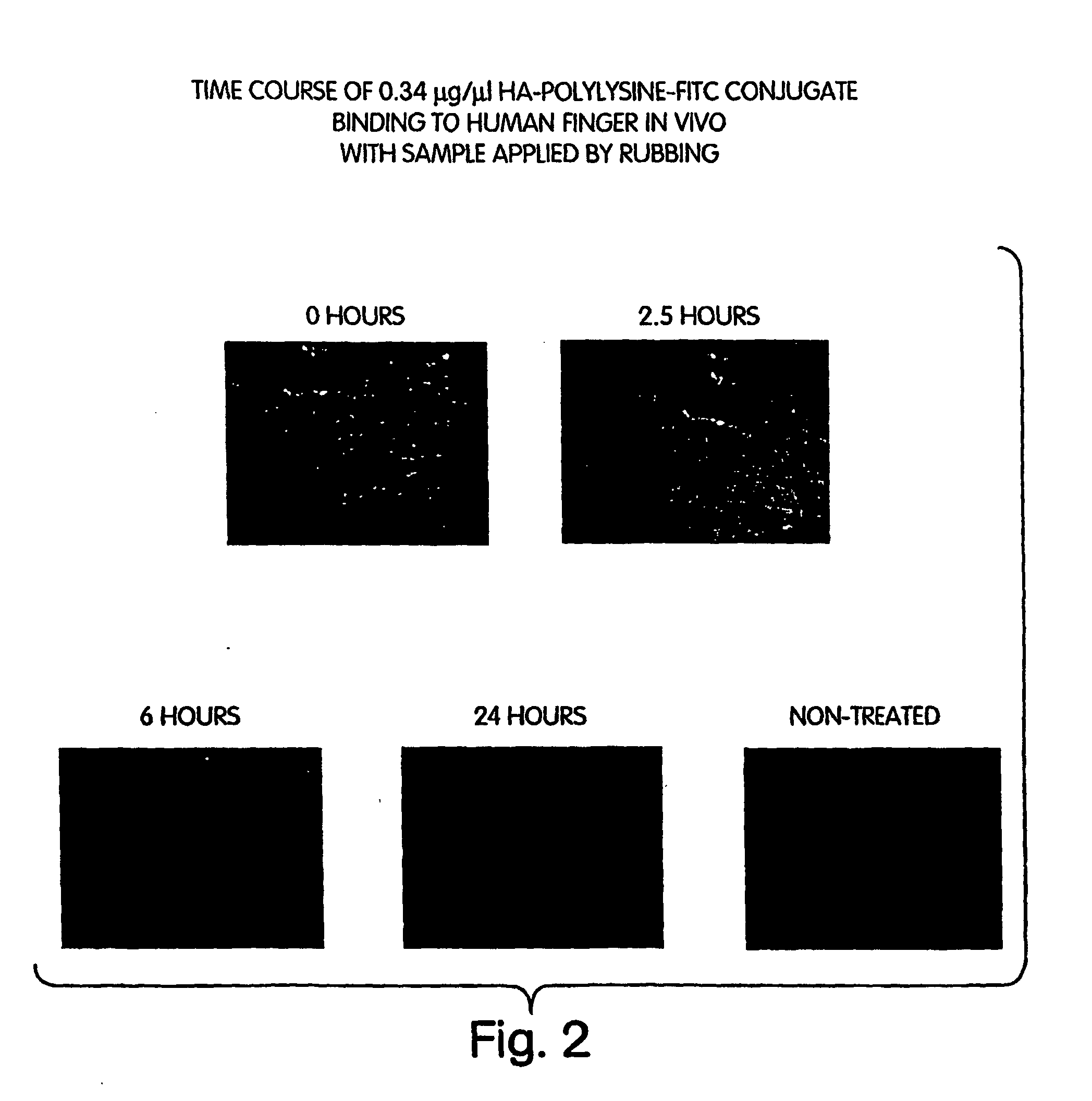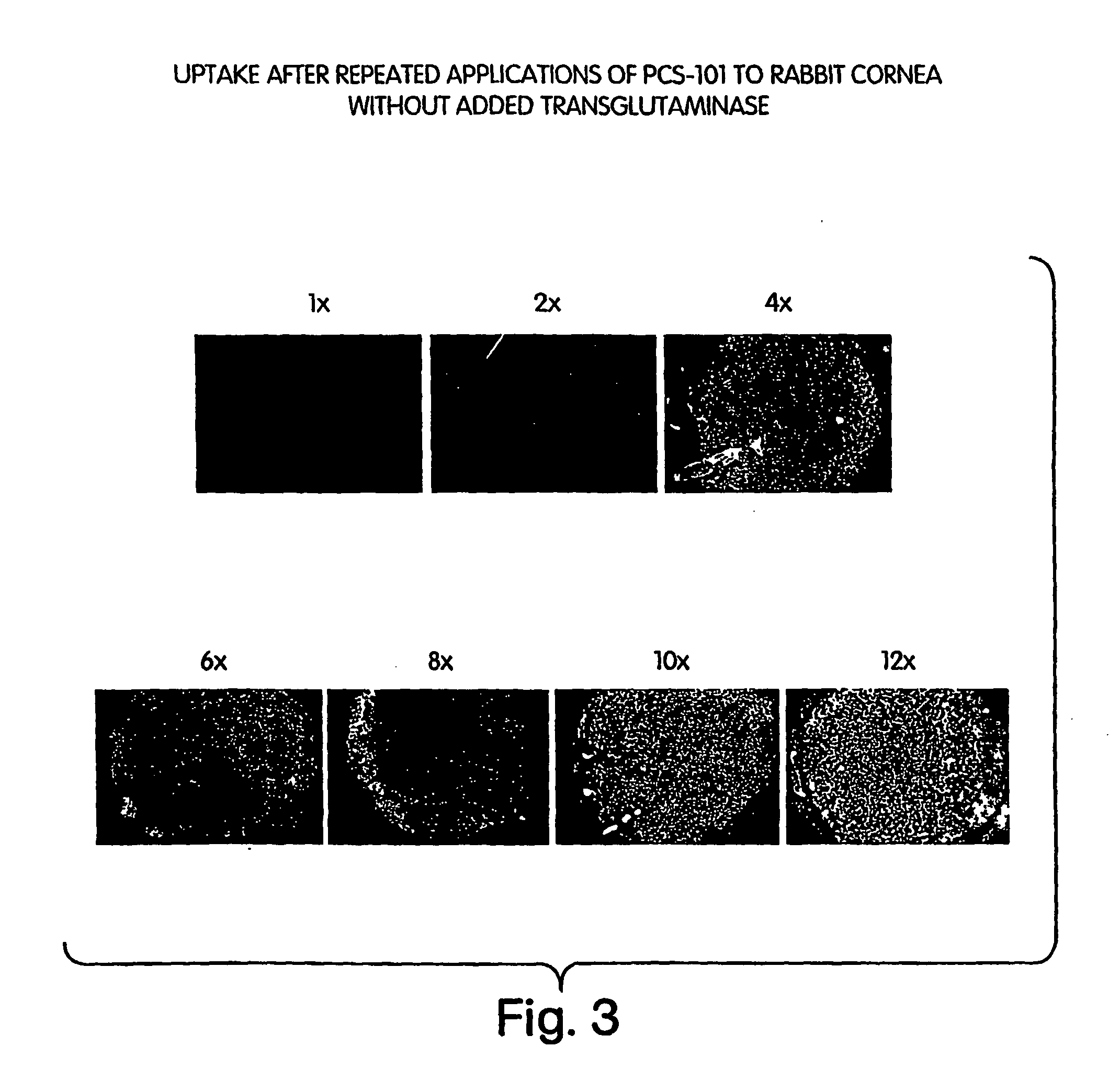Compositions of hyaluronic acid and methods of use
a technology of hyaluronic acid and composition, which is applied in the field of compositions of hyaluronic acid and methods of use, can solve the problems of abnormal or inadequate tear formation, and dehydration of the exposed outer surface, so as to inhibit platelet clotting, prolong the prophylactic and/or therapeutic effect, and enhance the effect of hyaluronic acid in alleviating dry eye and dry mouth
- Summary
- Abstract
- Description
- Claims
- Application Information
AI Technical Summary
Benefits of technology
Problems solved by technology
Method used
Image
Examples
example 1
Conjugation of Poly(L-Lysine) with Hyaluronic Acid Via Reductive Amination
Introduction:
[0206] Conjugation of polylysine (PLL) to hyaluronic acid (HA) is based on the ability of the aldehyde group of the terminal sugar residue of hyaluronic acid to form a Schiff base with -amino groups of polylysine. The formed Schiff base is not stable and is easily reversed by hydrolysis. A number of reducing agents can be used to convert the Schiff base into a stable secondary amine. The reduction reaction is best facilitated by sodium cyanoborohydrate because of the high reactivity of this reagent toward the Schiff base and low reactivity to the aldehyde group.
Materials and Methods:
[0207] Hyaluronic acid with molecular weight viscosity average of 220,000, in its sodium salt form, was purchased from Lifecore Biomedical (Chaska, Minn.). FITC labeled poly-L-Lysine (i.e., PLL-FITC), with a molecular weight of 15,000-30,000 and degree of substitution of 0.003-0.01 mole FITC per mole lysine mono...
example 2
Linking HA-PLL-FITC to in a Rabbit Eye Model
Materials and Methods:
[0213] The extent and duration of attachment of FITC-labeled polylysine and FITC-labeled polylysine conjugated to hyaluronic acid was tested using an in vivo rabbit cornea model. Ten New Zealand White rabbits were used in this randomized, double-masked, placebo controlled, single-centered, contralateral group, pre-clinical study.
[0214] Each rabbit eye was randomly assigned to one of four treatments: Active 1 (vehicle plus 0.42% FITC-labeled PCS-101 (hyaluronic acid conjugated to polylysine, including free hyaluronic acid in about a 1:1 molar proportion with conjugate; average molecular weight of HA is 220,000 Da, and of polylysine is 15,000-30,000 Da) (sample size of 9 eyes)); Active 2 (vehicle plus 2% FITC-labeled polylysine) (sample size of 4 eyes)), vehicle (20 mM sodium borate, pH 7.8 plus 80 mM NaCl) (sample size of 5 eyes); and placebo (phosphate-buffered saline (PBS), pH 7.4) (sample size of 2 eyes). The fl...
example 3
Ability of HA-Polylysine Conjugate to Bind to the Cornified Layer of Human Finger In Vivo
Materials and Methods:
[0224] Reaction solutions are 0.34 μg / μl HA-PLL-FITC conjugate (by PLL-FITC content) in 0.1 M glycine buffer 0.15 M NaCl, pH 8 in a total reaction volume of 20 μl
[0225] Human finger was rinsed in water and dried, after which the reaction solution was applied. The reaction solution was rubbed onto the skin using a powder free finger cot for 10 seconds, and left to dry at room temperature. The finger was then washed with water and dried. At various time-points after washing (0, 2.5, 6, and 24 hours), the top surface of the finger was photographed under FITC illumination (at 2× magnification) with a Spot RT digital camera (Diagnostic Instrument, Inc.).
Results:
[0226]FIG. 2 shows the data as a time course of 0.34 μg / μl of HA-PLL-FITC conjugate binding to human finger in vivo with the sample applied by rubbing. The time course runs from 0 hours, 2.5 hours, 6 hours and 24 h...
PUM
| Property | Measurement | Unit |
|---|---|---|
| Fraction | aaaaa | aaaaa |
| Fraction | aaaaa | aaaaa |
| Fraction | aaaaa | aaaaa |
Abstract
Description
Claims
Application Information
 Login to View More
Login to View More - R&D
- Intellectual Property
- Life Sciences
- Materials
- Tech Scout
- Unparalleled Data Quality
- Higher Quality Content
- 60% Fewer Hallucinations
Browse by: Latest US Patents, China's latest patents, Technical Efficacy Thesaurus, Application Domain, Technology Topic, Popular Technical Reports.
© 2025 PatSnap. All rights reserved.Legal|Privacy policy|Modern Slavery Act Transparency Statement|Sitemap|About US| Contact US: help@patsnap.com



